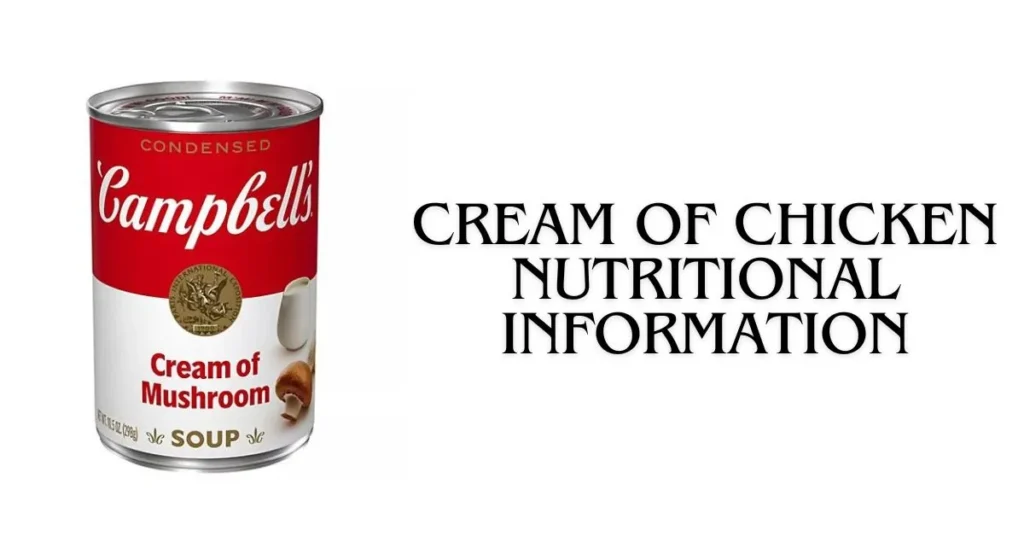Cream of chicken soup is a staple in many kitchens, cherished for its creamy texture and rich flavor. But have you ever wondered about its nutritional value? In this article, we’ll dive deep into the nutritional information of cream of chicken soup, exploring its benefits, potential drawbacks, and how it fits into a balanced diet. Whether you’re watching your calorie intake or curious about its ingredients, we’ve got you covered.
What Is Cream of Chicken Soup?
Cream of chicken soup is a savory and creamy concoction made primarily from chicken stock, cream, and often chunks of chicken. It’s widely used in recipes as a base for casseroles, sauces, and soups. The convenience of canned cream of chicken soup has made it a pantry essential for many households.
Key Nutritional Components:
Calories and Serving Size:
When examining the nutritional information of cream of chicken soup, one of the first things to consider is the calorie content. A typical serving size of cream of chicken soup is about 1/2 cup or 120 milliliters. This serving usually contains around 120-150 calories.
The calorie content can vary slightly depending on the brand and whether it’s a condensed version or ready-to-eat. Always check the label to get the most accurate information for your specific product.
Fat Content:
Cream of chicken soup is known for its creamy texture, which means it has a considerable amount of fat. In a standard serving, you can expect to find around 8-10 grams of fat. This includes both saturated and unsaturated fats. Saturated fat content is typically about 2-4 grams per serving, which can contribute to your daily intake.
Protein:
Chicken is the star ingredient in this soup, providing a moderate amount of protein. On average, a serving contains about 3-6 grams of protein. While not as high as some other protein sources, it can still contribute to your daily protein needs, especially when used as part of a larger meal.
Carbohydrates and Fiber:
A standard serving of cream of chicken soup contains about 8-10 grams of carbohydrates. This includes sugars, which are typically low, around 1-2 grams per serving. Fiber content is minimal, often less than 1 gram, since the soup is made mostly from liquid ingredients.
Sodium Content:
One of the most significant nutritional aspects to be aware of is the sodium content. Cream of chicken soup can be quite high in sodium, with a single serving containing anywhere from 600-900 milligrams. This high sodium content is something to watch, especially if you’re on a low-sodium diet or have high blood pressure.
Vitamins and Minerals:
Cream of chicken soup isn’t just about calories, fats, and protein. It also contains several important vitamins and minerals. Here’s a quick overview:
- Vitamin A: Often found in the form of beta-carotene, which is good for vision and immune function.
- Calcium: Important for bone health, although the amount can vary.
- Iron: Essential for oxygen transport in the blood.
These nutrients are present in varying amounts and can contribute to your daily intake.
Health Benefits of Cream of Chicken Soup:
Rich Source of Protein:
While not the highest source of protein, cream of chicken soup does provide a decent amount, which is essential for muscle repair and growth. This makes it a good option for those looking to increase their protein intake without consuming large amounts of meat.
Convenience and Versatility:
One of the biggest benefits is its convenience and versatility. It can be used in a variety of recipes, from casseroles to pasta dishes, making meal preparation easier and faster. This can be especially beneficial for busy individuals or families.
Comfort Food:
There’s something inherently comforting about a bowl of cream of chicken soup. It’s often associated with home-cooked meals and can provide a sense of nostalgia and warmth, which can be beneficial for mental well-being.
Potential Drawbacks:
High Sodium Content:
As mentioned earlier, the high sodium content is a significant drawback. Consuming too much sodium can lead to high blood pressure and other cardiovascular issues. It’s essential to monitor your intake and balance it with low-sodium foods throughout the day.
Calorie Density:
While the calorie content per serving isn’t excessively high, it’s important to consider the cumulative effect if you’re using cream of chicken soup in multiple recipes or consuming larger portions. This can contribute to weight gain if not balanced with physical activity and other low-calorie foods.
Comparing Homemade vs. Canned Cream of Chicken Soup:
Homemade Version:
Making cream of chicken soup at home allows you to control the ingredients and nutritional content. You can use fresh chicken, low-sodium broth, and control the amount of cream or milk used. This can result in a healthier version with fewer preservatives and additives.
Canned Version:
The convenience of canned cream of chicken soup can’t be denied. It’s ready to use and has a long shelf life. However, it often contains higher amounts of sodium, preservatives, and sometimes artificial flavors. Reading labels and choosing brands with better nutritional profiles can help mitigate some of these concerns.
How to Make a Healthier Cream of Chicken Soup?
Use Low-Sodium Broth:
One of the easiest ways to reduce the sodium content is to use a low-sodium broth. Many brands offer low-sodium versions, which can significantly cut down the overall sodium content of your soup.
Substitute Cream with Milk or Greek Yogurt:
To reduce the fat content, consider substituting heavy cream with milk or Greek yogurt. Both options can provide a creamy texture without the added saturated fats. Greek yogurt also adds extra protein, making your soup even more nutritious.
Add More Vegetables:
Incorporating more vegetables like carrots, celery, and peas can enhance the nutritional value of your soup. Vegetables add fiber, vitamins, and minerals, making your soup a more balanced meal.
Cream of Chicken Soup in Recipes:
Casseroles:
Cream of chicken soup is a popular ingredient in many casseroles. It adds moisture and flavor, making dishes like chicken and rice casserole or green bean casserole more delicious and comforting.
Sauces and Gravies:
Using cream of chicken soup as a base for sauces and gravies can save time and add a rich flavor. It’s perfect for dishes like chicken pot pie or creamy pasta sauces.
Soups and Stews:
Of course, cream of chicken soup can be used as a base for other soups and stews. Adding extra chicken, vegetables, and spices can transform it into a hearty and nutritious meal.
Tips for Incorporating Cream of Chicken Soup into a Healthy Diet:
Watch Your Portions:
Pay attention to the portion sizes you consume. Stick to the recommended serving size and balance it with other low-calorie, nutrient-dense foods throughout the day.
Pair with Whole Grains:
Combining cream of chicken soup with whole grains like brown rice or quinoa can make a more balanced meal. Whole grains add fiber and additional nutrients, helping you feel fuller for longer.
Balance with Fresh Ingredients:
Whenever possible, balance the richness of the soup with fresh ingredients like leafy greens, lean proteins, and a variety of vegetables. This can help offset some of the higher calorie and fat content.
Conclusion:
Cream of chicken soup is a versatile and convenient ingredient that can enhance many dishes. While it offers some nutritional benefits, such as protein and essential vitamins, it’s important to be mindful of its high sodium and fat content. By making smarter choices, like using low-sodium broth and adding more vegetables, you can enjoy cream of chicken soup as part of a balanced diet. Whether you opt for homemade or canned, understanding the nutritional information helps you make informed decisions and enjoy this creamy delight healthily.







